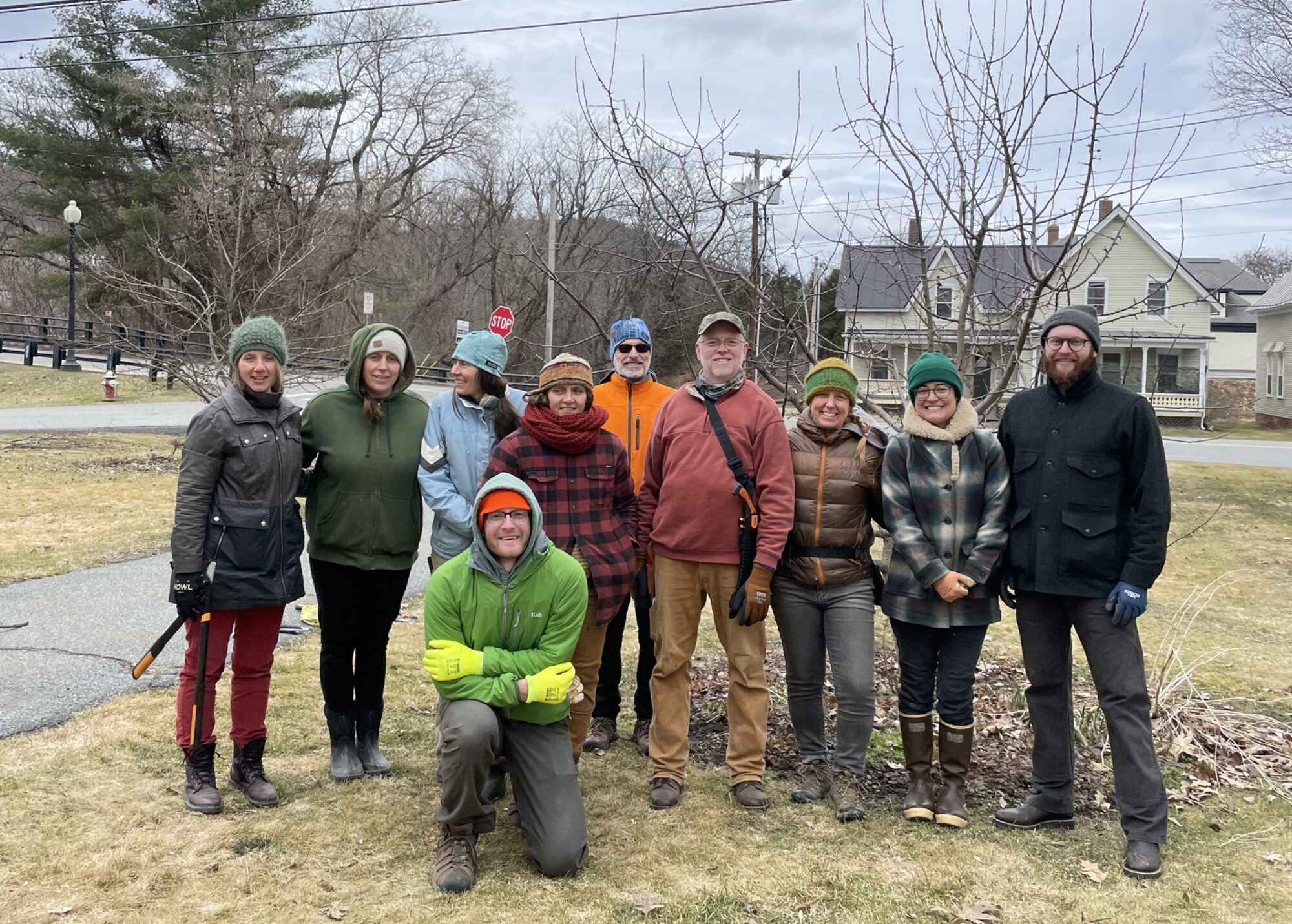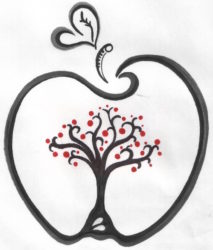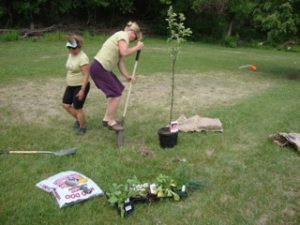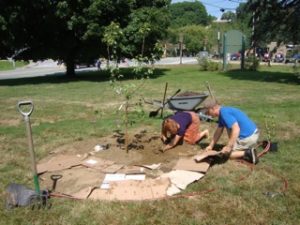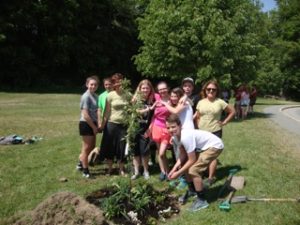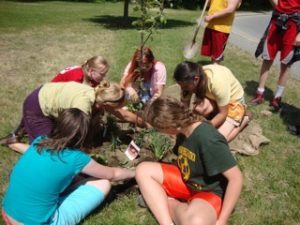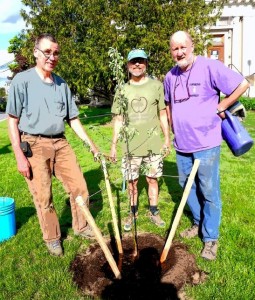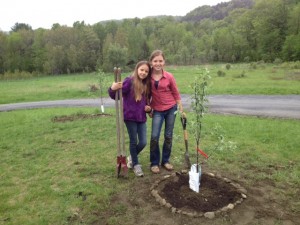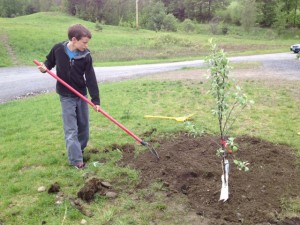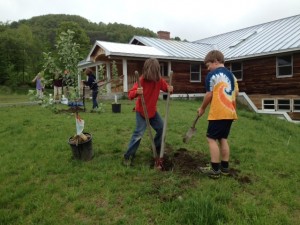Come See Our Established Sites
In White River Junction, VT:
Bugbee Senior Center: One pear tree and one apple tree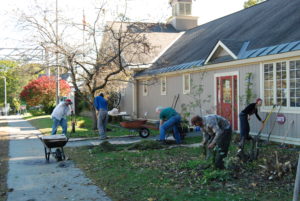
Clifford Park Food Forest: Resilient Hartford, a town commission of volunteers committed to making Hartford a more resilient community, is working with the Hartford Parks and Recreation Department on a plan to develop a portion of Clifford Park into a food resource for neighbors of the park and Hartford residents. The project began in 2021 with plantings of fruit and nut trees.
Upper Valley Food Co-op: 2 plum trees
Ratcliffe Park: Raspberry Revolution Park has been relocated here as of Spring 2020 from COVER Home Repair Store due to construction
Center for Transformational Practice: 1 peach tree (Reliance), 5 apple trees (Cortland, Sweet 16, Freedom, Liberty, Yellow Transparent), and 1 heartnut tree
Hartford Town Hall/Lyman Point Park: 2 apple trees by playground at Lyman Point Park (Cortland, Mac). 2 apple trees (Freedom, Liberty) and 2 pear trees (Luscious, Summer Sweet) in front of Town Hall building. A new demonstration rain garden and water catchment/rain barrel system is being installed in 2021 and 2022 by the bandshell.
Hartford Historical Society / Garipay House: 1 chestnut tree
Upper Valley Haven: Honeyberry bushes, hazelberts, 1 peach tree (Reliance)
White River School: 1 plum tree and 3 apple trees, (Mac, Macoun, Mutsu)
Susanne and George Abetti: 923 Kings Highway, White River Junction. 2 apple trees (Halal Red, Honeycrisp)
Birdie Emersons: 2 peach trees (Contender)
In South Strafford, VT:
Strafford Edible Pocket Park : 238 Rte 132 in South Strafford. 2 apple trees and an array of amazing fruit in the pocket park, located at the corner of the ball field. This is a public park inspired by Apple Corps and created by Barbara and Wally Smith.
Sustainable Strafford: 227 Justin Morrill Memorial Highway in South Strafford. 2 apple trees (Snow Sweet, Honeycrisp) by the tennis courts
In Windsor, VT:
Mt. Ascutney Hospital: Hazelbert shrubs and 2 apple trees
Windsor Middle & High School: 2 apple trees (Rose Mountain)
In Hartland, VT:
Heartland Farm: 2 peach trees (Contender), 1 apple tree (Mutsu ), 2 cherry trees (Montmorency)
First Unitarian Universalist Church in Hartland: 2 apple trees (Liberty, Honeycrisp)
In Other Locations around the Upper Valley:
Mascoma Greenway: 3 apple trees, 3 blueberry bushes, 2 elderberry bushes, 2 red osier dogwoods, 1 aronia, 1 high bush cranberry, 1 rose, 1 buttonbush
Kilton Library in West Lebanon, NH: 2 pear trees (Parker, Luscious)
Lebanon Public Library in Lebanon, NH: 1 apple tree (Granny Smith)
French Farm in Norwich, VT: 2 apple trees (Snow Sweet, Honeycrisp), 2 pear trees (Luscious, Parker)
Wellspring Waldorf School in Tunbridge, VT: 2 apple trees (Cortland)
Want to Share a Site?
While we love the idea of unlimited public access to our Apple Corps trees, this is not a requirement for a site proposal. As long as each site owner agrees to a reasonably generous sharing plan, their offer will be considered along with the others for each scheduled tree purchase and planting. Here are some example sharing plans that our coordinators have been discussed. If these options do not fit your needs, we encourage you to be creative!
-
-
Full public access: the site owner is comfortable allowing people to visit the tree(s) as they wish. These sites will be given priority when there fewer tree sponsors and adopters than proposed sites.
-
-
-
Public access by invitation: the site owner will communicate with the wider community when fruit is ready to harvest, specifying dates and times that the site is available for harvesting visits. This communication may include notifying the Apple Corps via phone or email so the information can be posted on our website.
-
-
-
School community: the trees are planted on school property. The school will control and coordinate the harvesting process for the benefit of the students and staff.
-
-
-
Neighbor access: the site owner has granted access to one or more specified neighbors.
-
-
-
Produce sharing: the site owner will pick the fruit / nuts themselves and give a specified percentage of the produce to specified friends, neighbors and/or community organization(s).
-
Remember, the above plans are just examples, you may submit your own version when you make your site proposal!
-
When we match tree sponsors and adopters to sites, we will ensure that they are aware of and agree to the sharing plan before resources are committed. Regardless of the sharing plan you use for your site, you will need to allow full access to the tree adopter(s) that will be caring for the tree(s). Of course, that is easy if you care for them yourself!
It is fun and exciting to plant fruit trees, but there are a few considerations in order to ensure healthy, long lasting fruit production into the future.
What happens to the agreement I make with the Apple Corps, when I sell my property?
That is entirely up to you. We encourage you to leave the Apple Corps plaque(s) for your tree(s) in place as you show the property and help to explain the benefits you and the community have reaped to prospective buyers. But we don’t expect you to require new owners to adopt the agreement you have made in order for them to be considered as new owners.
If I host an Apple Corps tree planting on my property, who will own the trees?
The legal entity or person that owns the land will own the tree(s). There is no formal, legal ownership or public right-of-way required or implied.
I’m in! How do I choose a good spot on my site for a tree?
Site Selection
Fruit trees need deep, well-drained sandy loam soil with good moisture and nutrient-holding capacity. Full sunlight nearly all day long is essential with a minimum of 6 hours to ensure maximum health. Watch the sun on your site carefully and ask neighbors who have been around for a while to determine if you have a site that receives 8 hours of sun a day. Six to eight is with-in reason. Trees that do not receive at least 6-8 hours of direct sunlight each day will be “leggy” and will produce few flowers and fruits.
Next, to have a success we encourage you to go to the UVM soil testing site. It explains how to take the soil test. It costs a small fee but it is well worth the investment to make sure you have a good site. Your site overall should be somewhat sandy, not rocky.
Further steps for success include care and maintenance of the fruit trees. See the resource information here and plan to attend our educational workshops.
Please propose your site and our experts will schedule a time to visit as needed. We will favor providing trees for the most suitable sites offered, in consideration of the environment, community sharing plan, and local adopter availability.
Species Selection
We are offering you a choice of Apples, Pears, Plums, or Peaches and will provide you varieties hardy to this region. Here is some information to consider in your choice of fruit.
· Apples, pears, plums (except European plums, many of which are generally self-fruitful) require cross-pollination to set fruit. For cross-pollination to occur, two different varieties of the same fruit must be grown (i.e. McIntosh and Delicious apples).
For the most part we are planting the following trees. However, if site owners have recommendations for other types of trees we will consider them.
Apples
Mutsu, Cortland, Granny Smith, Honeycrisp, Macoun
Pears
Luscious, Parker, Bartlett
Peaches (only planted in limited locations)
Reliance, Contender
Nuts
American Chestnuts, Chinese Chestnuts, Hazelnuts (Filberts), Buartnuts
Spacing between trees can be 15 – 25 ft. apart.
Have other questions? Please ask!
